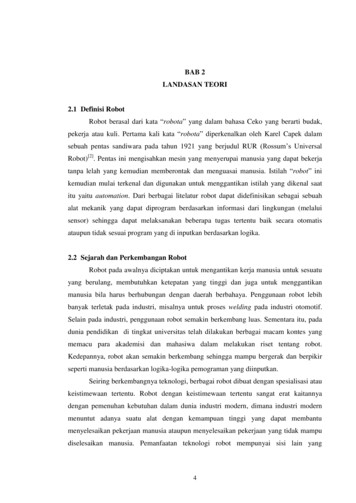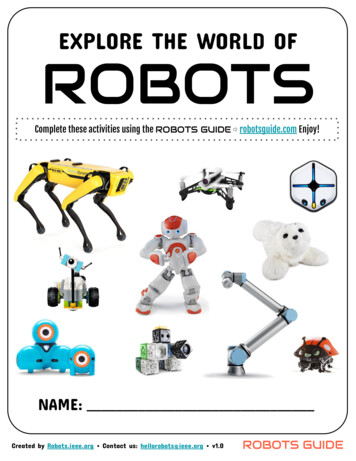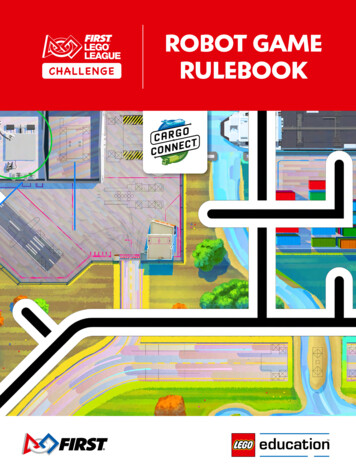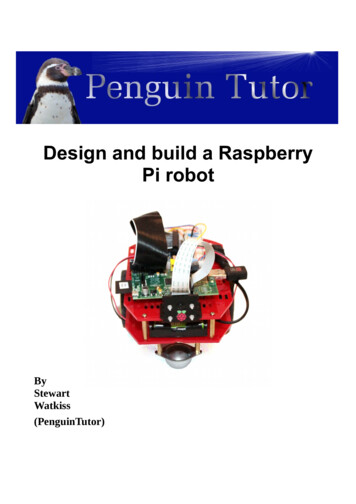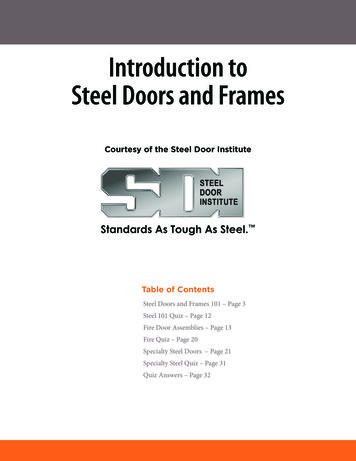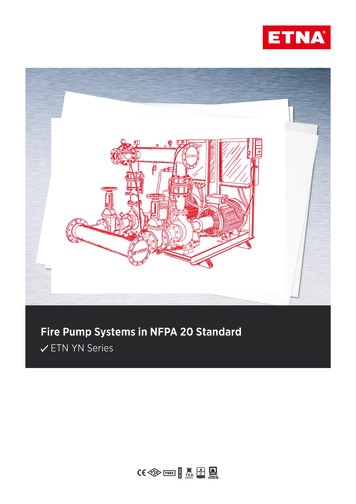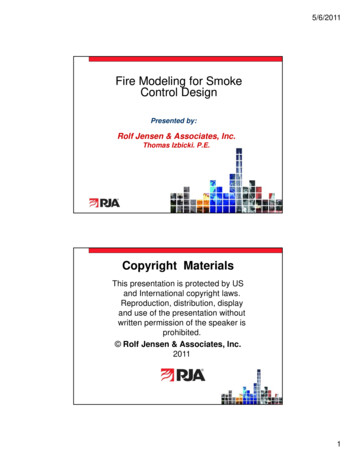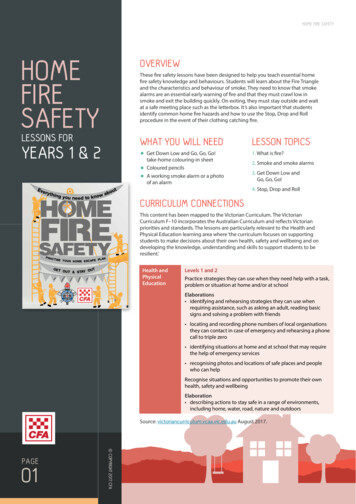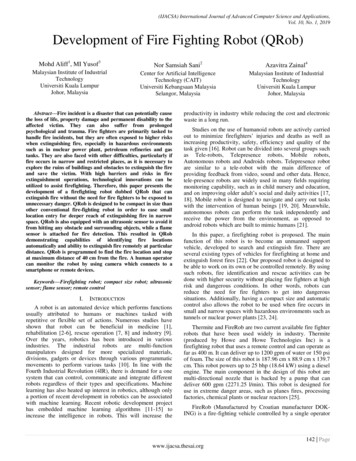
Transcription
(IJACSA) International Journal of Advanced Computer Science and Applications,Vol. 10, No. 1, 2019Development of Fire Fighting Robot (QRob)Mohd Aliff1, MI Yusof3Nor Samsiah Sani2Azavitra Zainal4Malaysian Institute of IndustrialTechnologyUniversiti Kuala LumpurJohor, MalaysiaCenter for Artificial IntelligenceTechnology (CAIT)Universiti Kebangsaan MalaysiaSelangor, MalaysiaMalaysian Institute of IndustrialTechnologyUniversiti Kuala LumpurJohor, MalaysiaAbstract—Fire incident is a disaster that can potentially causethe loss of life, property damage and permanent disability to theaffected victim. They can also suffer from prolongedpsychological and trauma. Fire fighters are primarily tasked tohandle fire incidents, but they are often exposed to higher riskswhen extinguishing fire, especially in hazardous environmentssuch as in nuclear power plant, petroleum refineries and gastanks. They are also faced with other difficulties, particularly iffire occurs in narrow and restricted places, as it is necessary toexplore the ruins of buildings and obstacles to extinguish the fireand save the victim. With high barriers and risks in fireextinguishment operations, technological innovations can beutilized to assist firefighting. Therefore, this paper presents thedevelopment of a firefighting robot dubbed QRob that canextinguish fire without the need for fire fighters to be exposed tounnecessary danger. QRob is designed to be compact in size thanother conventional fire-fighting robot in order to ease smalllocation entry for deeper reach of extinguishing fire in narrowspace. QRob is also equipped with an ultrasonic sensor to avoid itfrom hitting any obstacle and surrounding objects, while a flamesensor is attached for fire detection. This resulted in QRobdemonstrating capabilities of identifying fire locationsautomatically and ability to extinguish fire remotely at particulardistance. QRob is programmed to find the fire location and stopat maximum distance of 40 cm from the fire. A human operatorcan monitor the robot by using camera which connects to asmartphone or remote devices.Keywords—Firefighting robot; compact size robot; ultrasonicsensor; flame sensor; remote controlI.INTRODUCTIONA robot is an automated device which performs functionsusually attributed to humans or machines tasked withrepetitive or flexible set of actions. Numerous studies haveshown that robot can be beneficial in medicine [1],rehabilitation [2-6], rescue operation [7, 8] and industry [9].Over the years, robotics has been introduced in variousindustries. The industrial robots are multi-functionmanipulators designed for more specialized materials,divisions, gadgets or devices through various programmaticmovements to perform various tasks [10]. In line with theFourth Industrial Revolution (4IR), there is demand for a onesystem that can control, communicate and integrate differentrobots regardless of their types and specifications. Machinelearning has also heated up interest in robotics, although onlya portion of recent development in robotics can be associatedwith machine learning. Recent robotic development projecthas embedded machine learning algorithms [11-15] toincrease the intelligence in robots. This will increase theproductivity in industry while reducing the cost and electronicwaste in a long run.Studies on the use of humanoid robots are actively carriedout to minimize firefighters’ injuries and deaths as well asincreasing productivity, safety, efficiency and quality of thetask given [16]. Robot can be divided into several groups suchas Tele-robots, Telepresence robots, Mobile robots,Autonomous robots and Androids robots. Telepresence robotare similar to a tele-robot with the main difference ofproviding feedback from video, sound and other data. Hence,tele-presence robots are widely used in many fields requiringmonitoring capability, such as in child nursery and education,and on improving older adult’s social and daily activities [17,18]. Mobile robot is designed to navigate and carry out taskswith the intervention of human beings [19, 20]. Meanwhile,autonomous robots can perform the task independently andreceive the power from the environment, as opposed toandroid robots which are built to mimic humans [21].In this paper, a firefighting robot is proposed. The mainfunction of this robot is to become an unmanned supportvehicle, developed to search and extinguish fire. There areseveral existing types of vehicles for firefighting at home andextinguish forest fires [22]. Our proposed robot is designed tobe able to work on its own or be controlled remotely. By usingsuch robots, fire identification and rescue activities can bedone with higher security without placing fire fighters at highrisk and dangerous conditions. In other words, robots canreduce the need for fire fighters to get into dangeroussituations. Additionally, having a compact size and automaticcontrol also allows the robot to be used when fire occurs insmall and narrow spaces with hazardous environments such astunnels or nuclear power plants [23, 24].Thermite and FireRob are two current available fire fighterrobots that have been used widely in industry. Thermite(produced by Howe and Howe Technologies Inc) is afirefighting robot that uses a remote control and can operate asfar as 400 m. It can deliver up to 1200 gpm of water or 150 psiof foam. The size of this robot is 187.96 cm x 88.9 cm x 139.7cm. This robot powers up to 25 bhp (18.64 kW) using a dieselengine. The main component in the design of this robot aremulti-directional nozzle that is backed by a pump that candeliver 600 gpm (2271.25 l/min). This robot is designed foruse in extreme danger areas, such as planes fires, processingfactories, chemical plants or nuclear reactors [25].FireRob (Manufactured by Croatian manufacturer DOKING) is a fire-fighting vehicle controlled by a single operator142 Pagewww.ijacsa.thesai.org
(IJACSA) International Journal of Advanced Computer Science and Applications,Vol. 10, No. 1, 2019via remote control. It extinguishes fire without intervention offire fighters with a high pressure on a hydraulic arm thatpumps water up to 55 m away. It also can carry 1800 litre ofwater and 600 litre of foam in its two on board tanks. Thecoating on FireRob allows it to withstand critical temperatureof 250ºC and thermal radiation of 23 kW/m for a period of 30minutes.In this study, a compact and small firefighter robot hasbeen developed. This robot is named QRob, which is shortform of Rescue Robot. This robot can evade obstacles, searchand extinguish fire. Furthermore, this robot can increase theproductivity, safety, efficiency and quality of the task given.QRob is more compact and more flexible compared toThermite and FireRob robot. Another advantage of QRob is inits ability to enter location with small entrance or narrowspace.II. METHODOLOGYThe methodology is divided into three parts. The first partis on the mechanicals schematics, followed by hardwaredescription and the finally on the programming design. Allparts were assembled together and experiments were thenperformed to determine the optimal distance of QRob toextinguish the fire were carried out.A. Mechanical Design StructureGoogle SketchUp software and AutoCad were used toproduce 3D and 2D schematic diagram.For the main structure of the robot, to get the preferredmovement and speed, QRob have two wheels at rear side andtwo wheels at front side. The wheels have the ability tostabilize the robot and make rotation until 360 degrees. Thebody of the robot is made from acrylic plate to protect theelectronic circuit. The acrylic sheet is resistant to heat of up to200 ⁰ C. This gives the ability to use and work with (cut anddrill). The body of acrylic chassis contains holes that make iteasier to mounting of various type of sensors and othermechanical components.The ultrasonic sensor and flame sensor were installed atfront of the robot to avoid hitting any obstacles and to detectthe fire respectively. In addition, mini camera was installed infront side of the robot to monitor the way and condition of thelocation and is linked to the smart phone. The structure of firedistinguisher robot is shown in Fig. 1 and Fig. 2.Fig. 2. Firefighting Robot (QRob).B. Hardware ImplementationThe electronic part is one of the vital parts in thedevelopment of QRob. It includes the several types of sensors,microcontroller, DC motor with wheel, Transmitter andRemote control and Water pump. Fig. 3 shows the blockdiagram of the QRob operation which consists of flame sensorand ultrasonic sensor as input of the system. Arduino Uno isused as a microcontroller that connected with othercomponents. Motor Driver (L298N) is used to activate themoving of the gear motor while Transmitter Remote Controlwill give output of the system. Flow of water and fireextinguisher were pump after being controlled by the operator.On the other hand, the operator can monitor the robotmovements by using camera (Go Pro) which connects to asmartphone.1) Flame sensor: In most firefighting robots, fire sensorsperform an essential part in investigations, which are alwaysused as robot eyes to discover sources of fire [1]. It can beutilized to identify fire based on wavelength of the light at 760nm to 1100 nm. The detection angle and distance are roughly60 degrees and distance 20 cm (4.8V) to 100 cm (1V)respectively. Flame sensor has two signal pins that are DigitalOutput (DO) and Analog Output (AO). DO pins will give twokind of information that it’s has flame or non-flame while AOpins will detect exact wavelength of different light.Fig. 3. Block Diagram of QRob.Fig. 1. 3D Structure of QRob with Dimension.143 Pagewww.ijacsa.thesai.org
(IJACSA) International Journal of Advanced Computer Science and Applications,Vol. 10, No. 1, 20192) Ultrasonic sensor: One of the most crucial aspect ininventing an autonomous target detection robot is a barrier andobstacle avoidance. A sensor must be compact, low cost,simple to produce and functional on a larger scale. Moreover,it should be able to sense things with enough limits to letrobots to react and travel appropriately.The existing sensorsthat suit all these requirements are ultrasonic sensors. The HCSR04 ultrasonic sensor is utilized in this study to determinethe distance within the range of 2 cm to 400 cm with an angle15 degrees. This sensor transmits waves into the air andreceive reflected waves from the object. It has four output pinsuch as reference voltage (VCC) (operate around 5V), groundpin (GND), digital output (DO) and analog output (AO).3) DC motor with wheel: DC geared motor with rubberwheel are suitable material for this project. This DC motor aresuitable to replace 2 WD and 4 WD car chassis. The workingvoltage for DC motor is around 5V to 10 V DC. While theratio of the gear is 48:1. Suitable current for this motor is 73.2mA. DC motor is used to move the robot to the fire location.4) Water pump: The water pump is important part in thisrobot as it will pump water or soap to extinguish the firedepending on the class of fire that occurs. Small-size andlight-weight category of water pump has been selected for usein this project.Moreover, it has low noise, high effectiveness and minimalpower consumption. The optimal voltage for this water pumpis 6V. Working voltage for this water pump is around 4V to12V with the working current 0.8A.5) Transmitter and remote control: In this study, thewireless remote control transmitter and receiver with 4 controlmodes will be used. Model number of this receiver or remoteis S4C-AC110. This remote have four buttons. The operatingvoltage for this remote control is AC 100 – 120 V, while theworking voltage range of relay are AC 110 – 240 V or DC 0 –28 V. The model number of the transmitter is C-4. Thedistance of the remote control is 100 m or 300ft. Power supplyfor this transmitter are 12 V. The transmitting frequency is315 MHz / 433 MHz. By utilizing the transmitter and remotecontrol, QRob can be controlled from distant places where theoperator who controls it will be in a safe place while the robotwill enter into a dangerous fire area.At first, QRob is originally assumed to be at the centerposition with the coordinate point at the moment considered as(0, 0). When the rotation takes place on the z-axis, as shownas the θ in Fig. 4, the position change from the original to thefinal position gives a new coordinate to QRob and isconsidered as (x, y) on the coordinate plane. (Xm, Ym) in thefigure is the main surface coordinate plane and (Xr, Yr) is theQRob coordinate plane.[][][](1)Equation (1) is to determine the coordinate and angularposition for the QRob, where , and are the coordinatesregarding to the main surface plane (Xm, Ym) and and arethe driving and turning velocity with respect to the coordinatesregarding to the QRob coordinate plane (Xr, Yr). Then,adopting differential drive vehicle as the kinematic model ofQRob resulting,(()(2))(3)where r is radius of the wheel and d is the distance ofinstantaneous center of rotation.All the data from sensor is monitored and controlled byArduino. Fig. 5 shows the Arduino program which all theinput and output pin in Arduino need to be declared. Fig. 6shows the forward and reverse code movement for QRob tofind the fire location. Fig. 7 shows the flowchart of FireFighting Robot (QRob) using ultrasonic sensor and flamesensor. These codes will be used to program the movement ofQRob to find the fire location.III. CONTROL PROGRAMMINGFig. 4 shows the relationship between QRob coordinateplane with main surface plane.Fig. 4. Relationship between QRob Coordinate Plane with Main SurfacePlane.Fig. 5. Declaration Code.Fig. 6. Forward and Reverse Code Movement.144 Pagewww.ijacsa.thesai.org
(IJACSA) International Journal of Advanced Computer Science and Applications,Vol. 10, No. 1, 2019Fig. 8. Time to Extinguish Fire Depends on Distance of QRob with Fire.Fig. 9. Distance between QRob and Fire.From the experimental results, it can be seen that when thedistance between QRob and fire is greater, the longer it takesto extinguish the fire. For future planning, it is needed todetermine the optimal distance between QRob and fire. This isbecause to prevent QRob being too close to the fire and at thesame time can extinguish the fire in a short time.Fig. 7. Flowchart of Fire Fighting Robot (QRob).IV. RESULTFirefighting robot (QRob) has been developed to find thelocation of fire and extinguish it. QRob has an ability to findthe location by using flame sensor and ultrasonic sensor. Theflame sensor is functioning to sense the location of fire whileultrasonic sensor is functioning to detect the presence ofobject around the QRob. Both sensors are connected toArduino Uno, which controlled the movement of DC motor.B. Ability of QRob to Find Fire Location at DifferentDistance RouteQRob is equipped with ultrasonic sensor that allows it toavoid obstacles surround it. Thus, the maze has been designedto test whether the sensor works well and can avoids thebarrier as shown in Fig. 10.When flame sensor found the fire, the DC motor will stopat 40 cm from the fire. The operator will be extinguishing thefire using remote control from the distance. The operator alsocan monitor the QRob by using camera that connects to asmartphone.A. Time to Extinguish the Fire Depends on Distance of Qrobwith Fire SourceQRob successfully find fire location automatically andextinguish it by operator control. The operator can monitor thelocation of fire by camera that is connected to the smartphone.Fig. 8 shows the time to extinguish fire depends on distancebetween QRob and fire, and Fig. 9 shows the image during thefire extinguishing process.Fig. 10. Maze for Experiment.145 Pagewww.ijacsa.thesai.org
(IJACSA) International Journal of Advanced Computer Science and Applications,Vol. 10, No. 1, 20192) Ultrasonic Sensor Connectiona) This sensor will detect the object of theirsurroundings.b) This sensor ON when DC motor ON but FlameSensor will OFF.c) This sensor OFF when Flame sensor ON.When Ultrasonic Sensor 1; DC Motor 1,Flame Sensor 0,When Ultrasonic Sensor 0; DC Motor 0,Flame Sensor 1,3) DC MotorFig. 11. Time Taken Depends on Distance Route of QRob.a) This Motor is connecting with driver motor andArduino Uno.b) This Motor ON when Ultrasonic Sensor ON, FlameSensor OFF.c) This Motor OFF when Flame Sensor ON.When DC Motor 1; Ultrasonic Sensor 1,Flame Sensor 0,When DC Motor 0; Ultrasonic Sensor 0,Flame Sensor 1,VI. CONCLUSIONSFig. 12. Different Route Travelled by QRob to Fire Location.Fig. 11 indicates the time required to arrive at the firelocation is depend on the distance route of QRob. From theexperimental results, time taken to arrive at fire location isdirectly proportional to the distance route of QRob. Fig. 12shows that different fire location placed during theexperiment.V. DISCUSSIONThis project focuses on the development of firefightingrobot (QRob). In this section, the robot control sequence willbe discussed. From the results, this project is successfullyachieved which are:1) Flame Sensor Connection[1]a) The QRob will not react when the sensor not activateand the QRob will react when the sensor activates as well.b) This sensor is connecting with DC motor.c) This sensor OFF when fire was not detected and DCmotor and Ultrasonic Sensor ON.d) This sensor ON when fire is detected, then DC motorand Ultrasonic Sensor will automatically OFF.When Flame Sensor 1; DC Motor 0,Ultrasonic Sensor 0.When Flame Sensor 0; DC Motor 1,Ultrasonic Sensor 1.Overall, a fire-fighting robot that can be controlled fromsome distance has been successfully developed. It hasadvantageous features such as ability to detect location of fireautomatically besides having a compact body and lightweightstructure. QRob also has the ability to avoid hitting anyobstacle or surrounding objects due to its provision of anultrasonic sensor. The QRob robot can be used at a place thathas a small entrance or in small spaces because it has acompact structure. The operator is able to extinguish fire usingremote control from longer distance. Operators can alsomonitor the environmental conditions during the process offirefighting by using the camera that is connected to thesmartphone. From the experimental results, the robot cansense smokes and fire accurately in a short time. As aconclusion, the project entitled “Development of Fire FightingRobot (QRob)” has achieved its aim and lani, S., et al., Robotics and medicine: A scientific rainbow inhospital. Journal of Pharmacy & Bioallied Sciences, 2015. 7(Suppl 2): p.S381-S383.Aliff, M., S. Dohta, and T. Akagi, Simple Trajectory Control Method ofRobot Arm Using Flexible Pneumatic Cylinders. Journal of Robotics andMechatronics, 2015. 27(6): p. 698-705.Aliff M, D.S., and Akagi T, Control and analysis of simple-structuredrobot arm using flexible pneumatic cylinders. International Journal ofAdvanced and Applied Sciences, 2017. 4(12): p. 151-157.Aliff, M., S. Dohta, and T. Akagi, Control and analysis of robot armusing flexible pneumatic cylinder. Mechanical Engineering Journal,2014. 1(5): p. DR0051-DR0051.M. Aliff, S. Dohta and T. Akagi, Trajectory controls and its analysis forrobot arm using flexible pneumatic cylinders," IEEE InternationalSymposium on Robotics and Intelligent Sensors (IRIS), 2015, pp. 48-54.M. Aliff, S. Dohta and T. Akagi, Trajectory control of robot arm usingflexible pneumatic cylinders and embedded controller, IEEE146 Pagewww.ijacsa.thesai.org
(IJACSA) International Journal of Advanced Computer Science and Applications,Vol. 10, No. 1, onal Conference on Advanced Intelligent Mechatronics (AIM),2015, pp. 1120-1125.C. Xin, D. Qiao, S. Hongjie, L. Chunhe and Z. Haikuan, Design andImplementation of Debris Search and Rescue Robot System Based onInternet of Things, International Conference on Smart Grid andElectrical Automation (ICSGEA), 2018, pp. 303-307.Yusof, M., and Dodd, T., Pangolin: A Variable Geometry TrackedVehicle With Independent Track Control, Field Robotics, pp. 917-924.Day, C.-P., Robotics in Industry—Their Role in IntelligentManufacturing. Engineering, 2018. 4(4): p. 440-445.J. Lee, G. Park, J. Shin and J. Woo, Industrial robot calibration methodusing denavit — Hatenberg parameters, 17th International Conferenceon Control, Automation and Systems (ICCAS), 2017, pp. 1834-1837.Sani, N. S., Shamsuddin, I. I. S., Sahran, S., Rahman, A. H. A andMuzaffar, E. N, Redefining selection of features and classificationalgorithms for room occupancy detection, International Journal onAdvanced Science, Engineering and Information Technology, 2018, 8(42), pp. 1486-1493.Holliday, J. D., Sani, N., and Willett, P., Calculation of substructuralanalysis weights using a genetic algorithm, Journal of ChemicalInformation and Modeling, 2015, 55(2), pp. 214-221.Holliday, J. D., N. Sani, and P. Willett, Ligand-based virtual screeningusing a genetic algorithm with data fusion, Match: Communications inMathematical and in Computer Chemistry, 80, pp. 623-638.SamsiahSani, N., Shlash, I., Hassan, M., Hadi, A., and Aliff, M,Enhancing malaysia rainfall prediction using classification techniques,J. Appl. Environ. Biol. Sci, 2017, 7(2S), pp. 20-29.Sani, N.S., Rahman, M.A., Bakar, A.A., Sahran, S. and Sarim, H.M,Machine learning approach for bottom 40 percent households (B40)poverty classification, International Journal on Advanced Science,Engineering and Information Technology, 2018, 8(4-2), pp.1698-1705.Kim, J.-H., S. Jo, and B.Y. Lattimer, Feature Selection for IntelligentFirefighting Robot Classification of Fire, Smoke, and ThermalReflections Using Thermal Infrared Images. Journal of Sensors, 2016.2016: p. 13.[17] Tanaka, F., et al., Telepresence robot helps children in communicatingwith teachers who speak a different language, in Proceedings of the2014 ACM/IEEE international conference on Human-robot interaction.2014, ACM: Bielefeld, Germany. p. 399-406.[18] J. Ahn and G. J. Kim, Remote collaboration using a tele-presencemobile projector robot tele-operated by a smartphone, IEEE/SICEInternational Symposium on System Integration (SII), 2016, pp. 236241.[19] Harik, E.H. and A. Korsaeth, Combining Hector SLAM and ArtificialPotential Field for Autonomous Navigation Inside a Greenhouse.Robotics, 2018. 7(2): p. 22.[20] Acosta Calderon, C.A., E.R. Mohan, and B.S. Ng, Development of ahospital mobile platform for logistics tasks. Digital Communications andNetworks, 2015. 1(2): p. 102-111.[21] H. Hyung, B. Ahn, B. Cruz and D. Lee, Analysis of android robot lipsync factors affecting communication, 11th ACM/IEEE InternationalConference on Human-Robot Interaction (HRI), 2016, pp. 441-442.[22] R. N. Haksar and M. Schwager, Distributed Deep ReinforcementLearning for Fighting Forest Fires with a Network of Aerial Robots,IEEE/RSJ International Conference on Intelligent Robots and Systems(IROS), 2018, pp. 1067-1074.[23] J. Raju, S. S. Mohammed, J. V. Paul, G. A. John and D. S. Nair,Development and implementation of arduino microcontroller based dualmode fire extinguishing robot, IEEE International Conference onIntelligent Techniques in Control, Optimization and Signal Processing(INCOS), 2017, pp. 1-4.[24] Tushar Nandkishor Satbhai, R.M.K., Anant Vijay Patil, Manish Patil,Fire Fighting Robot. International Journal on Recent and InnovationTrends in Computing and Communication (IJRITCC), 2016. 4(4): p.799-803.[25] Nuţă, I., O. Orban, and L. Grigore, Development and Improvement ofTechnology in Emergency Response. Procedia Economics and Finance,2015. 32: p. 603-609.147 Pagewww.ijacsa.thesai.org
Google SketchUp software and AutoCad were used to produce 3D and 2D schematic diagram. For the main structure of the robot, to get the preferred movement and speed, QRob have two wheels at rear side and two wheels at front side. The wheels have the ability to stabilize the robot and make rotation until 360 degrees. The
